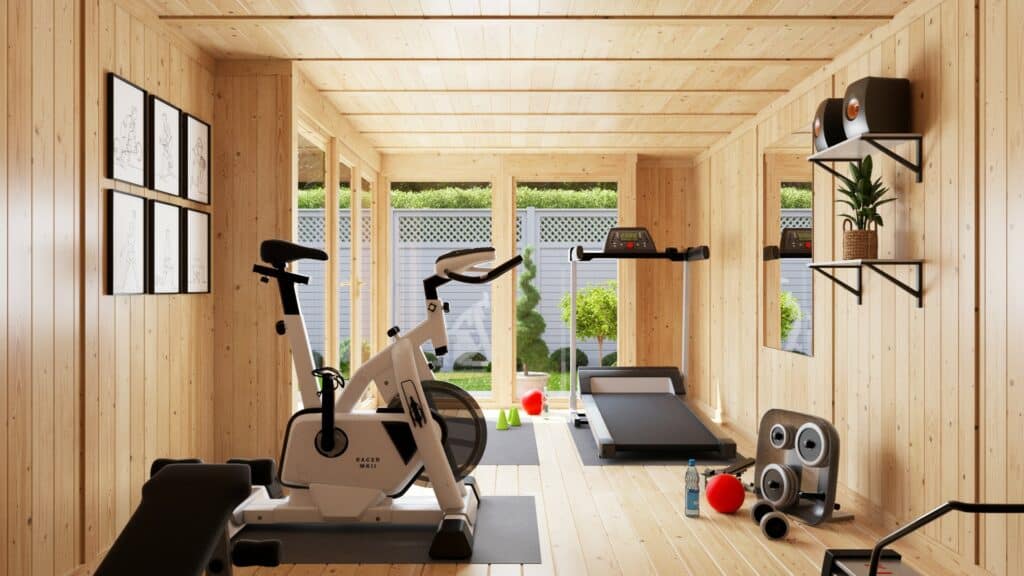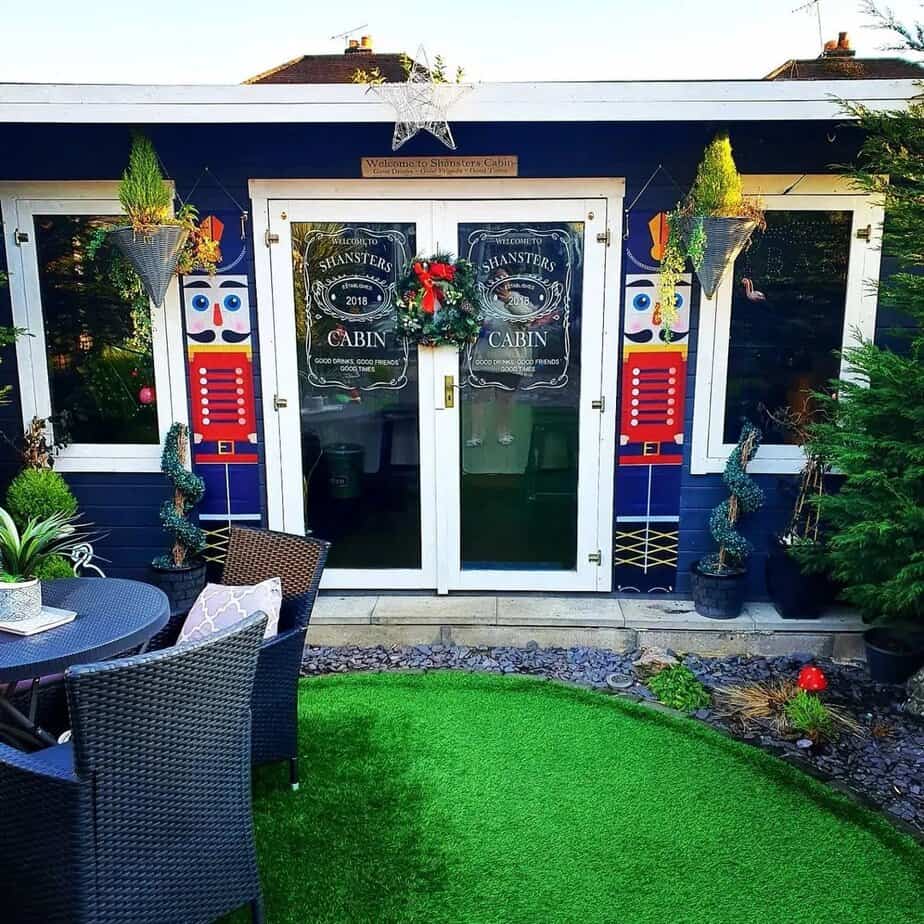Jump to:
There are lots of reasons to invest in a garden room for your home, whether it’s for work or pleasure. And those reasons should be taken into account when you’re selecting which of the many buildings on the market you want to choose. How you plan to use your new garden building goes hand-in-hand with how much you want to spend, and how much maintenance you are willing to do for it.
What is a Garden Room?

Garden rooms, sometimes called garden pods, are simple enough to explain: an additional building in your garden, separate from the house, designed for inhabiting comfortably for extended periods of time. They are set apart from garden sheds and garages by the fact that they are not used primarily for storage, gardening tasks or home DIY projects that would normally be undertaken in a workshop. Since garden rooms are meant to be used in a similar manner to other rooms of the home, they are also generally different from summerhouses, due to their warmer cladding and reduced focus on being open to the sun.
A garden room is often a more affordable, less disruptive and easier to build alternative to a house extension. So when you need to add another room to your home, building this in the garden is an excellent option.
Garden rooms are not for living in. While the goal is to create a warm, comfortable space, using them as overnight accommodation would mean you’d need planning permission. If you were to make it a completely livable building with plumbing and kitchen facilities, that would then affect your council tax. The Building Regulations could also become relevant for health and safety purposes, requiring the building to meet other standards. These issues won’t apply to you if you stick to using it as just a basic room.
Read more on the UK Beds in Sheds law.
While there are garden rooms of other materials on the market, our expertise lies primarily in wooden garden rooms, so that is what this guide will explore.
Should I Buy or Build My Own Garden Room?
If you’re especially good at DIY and you really know what you’re doing, it’s possible to spend less money by drawing up or downloading some plans, buying your own parts and building your own garden room. You get to make it as bespoke as you want, you can reinforce it, and there’s the added satisfaction of having created something from scratch.
If you’re curious, here’s what the process looks like for how to build a garden room.
However, here’s why most people will find it better to buy a prefabricated garden room kit:
- No excess waste materials, as the parts are already the correct size — in some cases, this will work out cheaper than having accidentally bought too much wood.
- Some suppliers offer to build it for you, and others will provide support if you need advice during the installation process.
- You have a route to return and exchange parts if anything goes wrong.
- You have assurance that your building is well-designed, with everything made to fit together.
- Panel-based buildings will already have pre-assembled wall components.
Choosing the Right Garden Room
To make the right investment for your garden (and maybe increase your property value while you’re at it), the main things you need to consider are:
- How much space you have
- Where you want to place it
- How you plan to use it
- Which style will match the surrounding garden
For example, the requirements for year-round use will be different from a seasonal summer retreat, in terms of the building’s timber thickness and insulation features.
Garden rooms placed in the corner of a garden might benefit from the inclusion of front and side windows to gain a complete view of the garden, while those placed at the end might be fine with front-only windows.
The right choice ultimately starts with your intended usage, so let’s start by looking at the different garden room types.
Types of Outdoor Rooms
Garden Offices for Working from Home

A home office workspace is one of the most common uses of a garden room. Whether this is for remote working within your employment, or a place from which to run your own business, more and more people are choosing to move their work into the garden.
Our full range of garden rooms can be used as an outdoor office, but some might be more suited to your particular work needs. For example, a simple desk and chair setup probably doesn’t need a particularly large room, but you might want to consider the insulation for long-term energy-efficient comfort. Other types of work uses such as hair salons will also want to consider the building styles and the ability to fit all necessary equipment inside.
“I wanted to separate the two and create a good work and life balance. It’s a great place to work. I have plenty of space to pack all my online orders that come from all over the world.” – Catharine, Verified Buyer
Top picks for an office garden room:
BillyOh Kent Garden Office – its classy, professional appearance create an excellent working environment, along with a multi-room partition on the larger size options.
BillyOh Outpost Insulated Garden Room – with insulation packed into the walls, floor and ceiling, along with double glazed windows by default, it will provide a secluded interior with comfort all year round.
Garden Gym Rooms

Garden rooms are a great place to take your home workouts, meaning you don’t have to fill your house with equipment or make noise on your floors.
Since this is a type of usage that has very specific requirements, we have a more curated selection of buildings for this, so visit our garden gyms page for the full range.
Or for further information, we have an extensive guide of what you need to know about garden gyms.
“I bought it because I’m a personal trainer, and needed somewhere to train my clients. The building is excellent! So far they all love it!” – Jamie, Verified Buyer
Top picks for a garden gym room:
BillyOh Devon Log Cabin – the tall reverse apex ceiling enables you to hang a boxing bag and perform jumping jacks. Make sure to choose the floor thickness upgrade for higher impact use.
BillyOh Tianna Log Cabin with Side Store – put your gym equipment away in the handy side shed when you’re finished, providing you with a garden room that is more multi-purpose. Again, the floor upgrade is recommended for gym usage.
Garden bar rooms

You can’t get much more British than a garden pub. Many of our customers have converted their sheds for this purpose, but here we’ll recommend the more comfortable and stylish garden rooms for the purpose. The main features you’ll want to look for are a suitable floor space, a good style, and the ability to decorate with your ideal theme.
Then it’s just a case of adding:
- A bar counter
- A fridge (with freezer for ice cubes)
- Internal lights
- Bar taps (unless you’re happy with just bottles)
“We’re using it as a bar – for drinking/dancing/playing board games with the kids on a Friday night. It’s allowed us to have a space away from the house to enjoy with friends so we don’t wake the kids up! Also, over the last year it’s allowed us to feel like we are sort of going out, even if it is just to the bottom of the garden!” – Emma, Verified Buyer
Top picks for a garden bar room:
BillyOh Fraya Pent Log Cabin – our bestselling garden room, this one is a simple style that is easy to make your own. It’s easy to make it warmer with the thicker timber and double glazing options.
BillyOh Renna Corner Summerhouse – more for the warmer half of the year when you’re most likely to be throwing garden parties, this summerhouse makes it easy to set up a bar opposite the doors.
Year round garden rooms

If you are looking for an outdoor room that you will be able to comfortably use every single day of the year, you need to look at our insulated wooden buildings. While you might still need to turn on some heating on the coldest days of the year, these rooms will effectively retain heat for a cosy environment.
These rooms are the ultimate choice for both work and leisure. Even at the coldest times of year, you can host movie nights, study, or just enjoy the garden, all with minimal heating required.
Top picks for a year-round garden room:
BillyOh Dojo E Insulated Building – our most premium garden room, this stunning building features huge windows, an external front platform, and a private corner area.
BillyOh Canvas Insulated Garden Room – a simple but smart building that is lined with insulation to make a great space for both private and social uses.
Garden room cladding options
Log cabin garden rooms

Most of our buildings that can be used as garden rooms are log cabins, meaning that they are built from individually stacked log boards which interlock at the corners for a distinctive look. But they aren’t just built this way for style; it also enables the wood to be thicker than on panel-based buildings such as sheds and summerhouses, and this provides you with an insulating element.
Our log cabins go up to 44mm in timber thickness, and the thicker they are, the more insulated they will be. You should consider this for not only how much of the year you want to use the room for, but for what purposes. A gym room, for example, might not need to be kept as warm as a full-time garden entertainment room or office.
In terms of insulation, it is also affected by whether or not you opt for a double glazing upgrade (our cabins are single glazed by default). But you should consider a 44mm log cabin to be comfortable for 9-10 months of the year.
Insulated panel garden rooms

Our other type of garden room cladding is structured insulated panels (SIP). These prefabricated panels make for easier assembly than a log cabin, since the boards are already fixed together. Our designers have made it simple to insert insulation materials inside the panels of the walls, floor and roof, with materials such as EcoFoil and expanded polystyrene (EPS). Combined with double glazed windows as standard, these garden rooms provide robust barriers against the cold.
Learn more: What are SIP Buildings?
Garden Room Sizes
When planning your garden room, size is one of the most important decisions you’ll make. The available space in your garden and how you intend to use the room will determine the best dimensions for your needs. Our Garden Room Size Guide covers all standard size options in more detail, but here’s a quick overview to help you get started.
Small Garden Rooms (Under 3m x 3m)
Compact garden rooms are ideal for home offices. A space of around 2.5m x 2.5m is usually enough for a desk, chair, and shelving, while keeping the building under most planning permission limits. If you’ll be working year-round, consider insulation or a 44mm log thickness for comfort.
Medium Garden Rooms (3m x 3m to 4m x 3m)
A medium-sized room is versatile and perfect for use as a garden gym. You’ll have enough space for a treadmill, bike, or weights bench, plus room to move around safely. For high-impact workouts, make sure to choose a thicker floor option for stability and durability.
Large Garden Rooms (4m x 3m to 5m x 4m)
For a garden bar or pub, a larger room allows for a bar counter, seating area, and fridge setup without feeling cramped. These sizes are great for entertaining, especially when paired with front-opening doors that connect the interior to your patio or garden.
Note that once you go over 15 square metres (internal floor space), you have to be careful about placing your garden room within 1 metre of your property boundary (which most people will). As these buildings are constructed of a combustible material (wood), this combination would mean that the Building Regulations now apply to your garden room. This is a matter of fire safety and making sure a fire can’t spread to your neighbours. In this situation, you would need to contact your local council and apply for approval, which might require you to make alterations such as moving the building or making it fire resistant.
Extra-Large Garden Rooms (Over 5m wide)
If you’re looking for a family lounge or multipurpose garden retreat, an extra-large building gives you the flexibility to include sofas, a TV, or even a dining area. These rooms feel like true garden extensions of your home and are well suited for all-year-round use when insulated.
Whatever your purpose, ensure there’s still outdoor space left for access and landscaping around the building. Visit our Log Cabin Sizes Guide to explore all available dimensions and find your perfect fit.
What’s included with a wooden garden room
With our garden rooms, you receive a complete building with the roof and floor. The roofs are covered with traditional felt, unless there are upgrades to alternative materials available.
Upgrades to the floor thickness, roof thickness, timber protection, and window glazing are available on log cabin garden rooms.
The following are not included with our garden rooms and will need to be acquired separately if you want them:
- Electricity supply
- Plumbing
- Lights
- Heating
- Installation service
Frequently Asked Garden Room Questions
Will I need planning permission for a garden room?
The short answer is: it depends.
Like most outbuildings, garden rooms don’t normally require special planning permission for normal domestic usage for most people. However, this will be different if the room is to be slept in overnight, and it can also face different requirements if being used to run a business.
For a full explanation, including size and height requirements, read our guide to garden room planning permission.
And if you’re planning to run your own business from your garden office, jump straight to planning permission for outdoor offices.
How do I maintain my garden room?
Maintenance for wooden garden rooms can be boiled down to 3 main areas:
- Maintaining the roof
- Maintaining the floor
- Treating the wood
The roof felt can take damage over time, especially after storms, so you should routinely check it to make sure no holes have started to appear.
Equally, the floor can take a lot of impact, so you should lift any carpets and check for damage. Replacing a damaged floorboard is best to be done as soon as possible for safety of use and for the integrity of the building.
In terms of treatment, the standard approach is to give a wooden building a fresh coat of preserver once a year. The best time of year to do this is at the end of summer, so you can prepare the building for winter while it’s still pleasant to do the work.
However, you can remove the need for this work by opting for the pressure treatment upgrade on your garden room. Adding pressure treatment not only extends your guarantee from 10 to 15 years, but it means you won’t have to treat the building yourself for a very long time (5-7 years). The main downside of this is that your building will arrive with a green tint to the wood, and it won’t be safe to paint over this for 4-6 months as the treatment still needs to dry.
By default, our garden rooms arrive either untreated or spray treated (which only protects the wood during transit).
How much does a garden room cost?
The initial price of your garden room can vary by size, cladding, and whether you choose any upgrades. The best way to measure the costs for yourself is to click through our product range and change between the size options.
However, there are other costs associated with a garden room beyond the purchase of the building itself, including the installation of a base and any utilities. Fortunately, our experts have written an extensive breakdown in our Garden Room Cost Guide.
How do I Add Electricity to my Garden Room?
There are a few methods, but the best one is to hire an electrician to run cabling from your house to the garden room.
Read our full guide on this question: Installing Garden Building Electricity.
Buy a Garden Room
Ready to make a purchase? Check out our full garden room range and prepare to open up a new way to experience your garden.
Shop Garden Rooms




